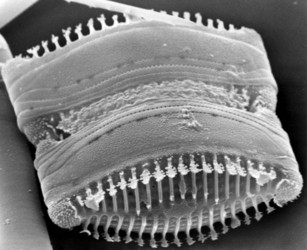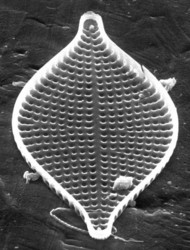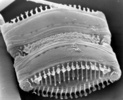clade I araphid pennate diatoms
David G. Mann


This tree diagram shows the relationships between several groups of organisms.
The root of the current tree connects the organisms featured in this tree to their containing group and the rest of the Tree of Life. The basal branching point in the tree represents the ancestor of the other groups in the tree. This ancestor diversified over time into several descendent subgroups, which are represented as internal nodes and terminal taxa to the right.

You can click on the root to travel down the Tree of Life all the way to the root of all Life, and you can click on the names of descendent subgroups to travel up the Tree of Life all the way to individual species.
For more information on ToL tree formatting, please see Interpreting the Tree or Classification. To learn more about phylogenetic trees, please visit our Phylogenetic Biology pages.
close boxIntroduction
These diatoms were never grouped together previously, in classifications based on morphology, but in molecular phylogenies (e.g. Kooistra et al. 2004, 2006, Medlin & Kaczmarska 2004, Sorhannus 2007) they consistently appear as a monophyletic group, although very few species have yet been grown and sequenced. No morphological synapomorphies have been identified for the group and there may be none. However, the cytological characteristics of most members have not been recorded and absolutely nothing is known about the reproductive biology of clade I araphid pennates, which is particularly unfortunate because it is conceivable that they might provide the key to understanding how the oogamy of centric diatoms was replaced by isogamy (rarely anisogamy).
All species known to belong to clade I araphid pennates are marine. The Plagiogrammaceae and Rhaphoneidaceae grow attached to rocks, sand grains and seaweeds (though like other benthic marine species, they are sometimes swept up into coastal plankton), living as solitary cells or forming chains or clusters. The exception is Neodelphineis, which is habitually planktonic and grows in zig-zag colonies (Round et al. 1990). Asterionellopsis and Asteroplanus are are both planktonic, forming helical or stellate colonies.
Clade I is discussed by Kooistra et al. (2004, 2006).
Clade I araphid pennates are apparently the first pennate diatoms to appear in the fossil record although, because the clade is characterized by molecular genetic data, any statements about its fossil record are rather speculative.
Characteristics
Clade I is based solely on molecular evidence (principally from SSU rDNA). No morphological synapomorphies have been identified. None of the features mentioned below is restricted to clade I araphids, and none is possessed by all clade II taxa.
- colonial (stellate or chain-forming) or solitary
- valves linear, lanceolate, square, triangular, consisting of a swollen base and hair like extension, elliptical, or circular!
- valve pattern organized with respect to a sternum, which can be wide (some Rhaphoneidaceae) or very narrow (some Plagiogrammaceae, Asterionellopsis). There is sometimes (e.g. Glyphodesmis) a circular boss at the centre of the valve, mimicking the annulus of centric diatoms. In Psammodiscus, if it belongs here, the sternum is reduced almost to nothing, and a lesser reduction is present in other Rhaphoneidaceae.
- pore fields sometimes present at the valve apices.
- rimoportulae sometimes present (Rhaphoneidaceae, Asterionellopsis), but lost in Plagiogrammaceae.
- areolae usually occluded by rotae or cribra (but not in Asterionellopsis).
References
Kooistra, W.H.C.F., Forlani, G., Sterrenburg, F.A.S. & De Stefano, M. (2004). Molecular phylogeny and morphology of the marine diatom Talaroneis posidoniae gen. et sp. nov. (Bacillariophyta) advocate the return of the Plagiogrammaceae to the pennate diatoms. Phycologia 43: 58-67.
Kooistra, W.C.H.F., Chepurnov, V., Medlin, L.K., De Stefano, M., Sabbe, K. & Mann, D.G. (2006). Evolution of the diatoms. In: Plant Genome: Biodiversity and Evolution. Vol. 2B: Lower Groups (Ed. by A.K. Sharma & A. Sharma), pp. 117-178. Oxford & IBH Publishing, New Delhi , India and Science Publishers, USA.
Medlin, L.K. & Kaczmarska, I. (2004). Evolution of the diatoms: V. Morphological and cytological support for the major clades and a taxonomic revision. Phycologia 43: 245–270.
Round, F.E., Crawford, R.M. & Mann, D.G. (1990). The diatoms. Biology and morphology of the genera. Cambridge University Press, Cambridge. 747 pp.
Sims, P.A., Mann, D.G. & Medlin, L.K. (2006). Evolution of the diatoms: insights from fossil, biological and molecular data. Phycologia 45: 361-402.
Sorhannus, U. (2007). A nuclear-encoded small-subunit ribosomal RNA timescale for diatom evolution. Marine Micropaleontology 65: 1-12.
Title Illustrations

| Scientific Name | Asterionellopsis glacialis |
|---|---|
| Comments | Transmission electron micrograph of basal section of valve, with pore field |
| Creator | Frank E. Round |
| Acknowledgements | This image is derived from the Professor Frank Round Image Archive at the Royal Botanic Garden Edinburgh |
| Specimen Condition | Dead Specimen |
| Identified By | David Mann |
| Life Cycle Stage | Vegetative phase |
| Body Part | Valve |
| View | Whole mount |
| Image Use |
 This media file is licensed under the Creative Commons Attribution-NonCommercial License - Version 3.0. This media file is licensed under the Creative Commons Attribution-NonCommercial License - Version 3.0.
|
| Copyright |
© 2008 David G. Mann

|
| Scientific Name | Dimeregramma |
|---|---|
| Creator | Frank E. Round |
| Acknowledgements | This image is derived from the Professor Frank Round Image Archive at the Royal Botanic Garden Edinburgh |
| Specimen Condition | Dead Specimen |
| Identified By | David Mann |
| Life Cycle Stage | Vegetative phase |
| Body Part | Dividing frustule |
| View | Exterior, SEM |
| Image Use |
 This media file is licensed under the Creative Commons Attribution-NonCommercial License - Version 3.0. This media file is licensed under the Creative Commons Attribution-NonCommercial License - Version 3.0.
|
| Copyright |
© 2008 David G. Mann

|
| Scientific Name | Rhaphoneis amphiceros |
|---|---|
| Specimen Condition | Dead Specimen |
| Identified By | David Mann |
| Life Cycle Stage | Vegetative phase |
| Body Part | Valve |
| View | Interior, SEM |
| Image Use |
 This media file is licensed under the Creative Commons Attribution-NonCommercial License - Version 3.0. This media file is licensed under the Creative Commons Attribution-NonCommercial License - Version 3.0.
|
| Copyright |
© 2008 David G. Mann

|
About This Page
This page is being developed as part of the Tree of Life Web Project Protist Diversity Workshop, co-sponsored by the Canadian Institute for Advanced Research (CIFAR) program in Integrated Microbial Biodiversity and the Tula Foundation.
David G. Mann

Royal Botanic Garden Edinburgh, United Kingdom
Correspondence regarding this page should be directed to David G. Mann at
Page copyright © 2008 David G. Mann
 Page: Tree of Life
clade I araphid pennate diatoms.
Authored by
David G. Mann.
The TEXT of this page is licensed under the
Creative Commons Attribution-NonCommercial License - Version 3.0. Note that images and other media
featured on this page are each governed by their own license, and they may or may not be available
for reuse. Click on an image or a media link to access the media data window, which provides the
relevant licensing information. For the general terms and conditions of ToL material reuse and
redistribution, please see the Tree of Life Copyright
Policies.
Page: Tree of Life
clade I araphid pennate diatoms.
Authored by
David G. Mann.
The TEXT of this page is licensed under the
Creative Commons Attribution-NonCommercial License - Version 3.0. Note that images and other media
featured on this page are each governed by their own license, and they may or may not be available
for reuse. Click on an image or a media link to access the media data window, which provides the
relevant licensing information. For the general terms and conditions of ToL material reuse and
redistribution, please see the Tree of Life Copyright
Policies.
- First online 07 February 2010
Citing this page:
Mann, David G. 2010. clade I araphid pennate diatoms. Version 07 February 2010 (under construction). http://tolweb.org/clade_I_araphid_pennate_diatoms/125304/2010.02.07 in The Tree of Life Web Project, http://tolweb.org/











 Go to quick links
Go to quick search
Go to navigation for this section of the ToL site
Go to detailed links for the ToL site
Go to quick links
Go to quick search
Go to navigation for this section of the ToL site
Go to detailed links for the ToL site